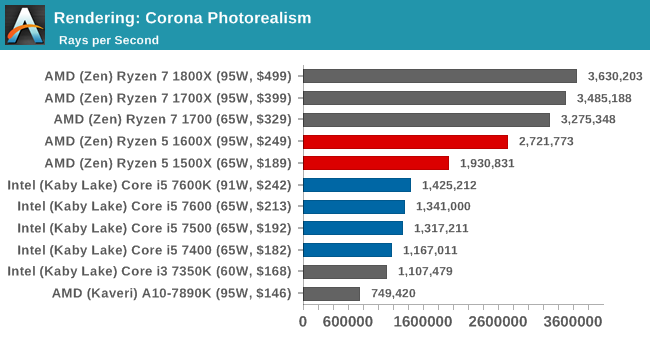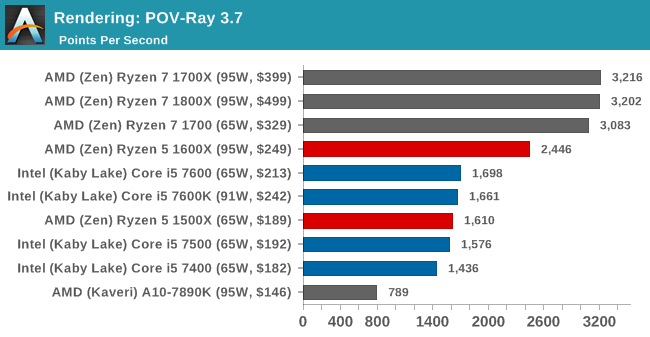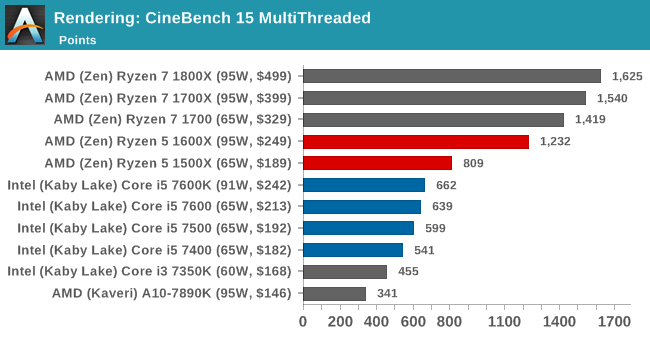The AMD Ryzen 5 1600X vs Core i5 Review: Twelve Threads vs Four at $250
by Ian Cutress on April 11, 2017 9:00 AM ESTBenchmarking Performance: CPU Rendering Tests
Rendering tests are a long-time favorite of reviewers and benchmarkers, as the code used by rendering packages is usually highly optimized to squeeze every little bit of performance out. Sometimes rendering programs end up being heavily memory dependent as well - when you have that many threads flying about with a ton of data, having low latency memory can be key to everything. Here we take a few of the usual rendering packages under Windows 10, as well as a few new interesting benchmarks.
Corona 1.3
Corona is a standalone package designed to assist software like 3ds Max and Maya with photorealism via ray tracing. It's simple - shoot rays, get pixels. OK, it's more complicated than that, but the benchmark renders a fixed scene six times and offers results in terms of time and rays per second. The official benchmark tables list user submitted results in terms of time, however I feel rays per second is a better metric (in general, scores where higher is better seem to be easier to explain anyway). Corona likes to pile on the threads, so the results end up being very staggered based on thread count.
Blender 2.78
For a render that has been around for what seems like ages, Blender is still a highly popular tool. We managed to wrap up a standard workload into the February 5 nightly build of Blender and measure the time it takes to render the first frame of the scene. Being one of the bigger open source tools out there, it means both AMD and Intel work actively to help improve the codebase, for better or for worse on their own/each other's microarchitecture.
POV-Ray 3.7.1
Another regular benchmark in most suites, POV-Ray is another ray-tracer but has been around for many years. It just so happens that during the run up to AMD's Ryzen launch, the code base started to get active again with developers making changes to the code and pushing out updates. Our version and benchmarking started just before that was happening, but given time we will see where the POV-Ray code ends up and adjust in due course.
Cinebench R15
The latest version of CineBench has also become one of those 'used everywhere' benchmarks, particularly as an indicator of single thread performance. High IPC and high frequency gives performance in ST, whereas having good scaling and many cores is where the MT test wins out.















254 Comments
View All Comments
Arbie - Wednesday, April 12, 2017 - link
I agree - this is implying the reverse of what was probably meant. And it's still broken.coder543 - Tuesday, April 11, 2017 - link
"For $250, the top Ryzen 5 1600X gives six cores and twelve threads of AMD’s latest microarchitecture, while $250 will only get you four cores and no extra threads for the same price."You're missing a word in here. That word is "Intel". Right now, the opening paragraph contains one of the most confusing sentences ever written, because the only brand mentioned is AMD, where $250 simultaneously gets you 6 cores and 12 threads *and* only 4 cores? Please update this paragraph to show that Intel only gets you 4 cores.
Arbie - Tuesday, April 11, 2017 - link
I agree - you really need to add "with Intel". This is a theme statement for the entire article and worth fixing.CaedenV - Tuesday, April 11, 2017 - link
Well, that review was surprising.I am looking to re-do my system in the next year or so, and I thought for sure that the R5 would be the no-brainer pick. But that seems not to be the case. If on a tight budget it looks like the i3 is the all-around value king offering great single-thread performance and decent light to moderate gaming. The i5 still reigns king for non-production work while being right about the same price point as the R5. And if doing production work the R7 really makes more sense as it is not that much more expensive while offering much better render performance. I somehow thought that the R5 would be better priced against the i5, just as the R7 stomps all over the i7 chips.
So now when I look at building my next PC the real question is how much production work I plan on doing. If it is a lot then the R7 is the way to go. But if I am just doing media consumption and gaming then perhaps the Intel i5 will still be the best option. Hmm... maybe I'll just wait a bit longer. I mean, my i7 2600 still keeps chugging along and keeping up. The real temptation to upgrade is DDR4, USB-C, m.2, and PCIe v3. Seeing more 10gig Ethernet would also be a big temptation for an upgrade, but I think we are still 2-3 years out on that. Any up-tick in raw CPU performance is really a secondary consideration these days.
snarfbot - Tuesday, April 11, 2017 - link
That is a strange position indeed, as it conflicts with all the data in the review.In other words lol wut?
Meteor2 - Wednesday, April 12, 2017 - link
Indeed. My conclusion was 'wow, AMD have knocked it out of the park'. Same or better gaming, far better production.Cooe - Monday, March 1, 2021 - link
What happened to your "Ryzen 5 will be shit" comments from all over the OG Ryzen 7 review???Drumsticks - Tuesday, April 11, 2017 - link
It's not really hard to figure out. If you just do media and gaming, stick with Intel.If you rely on your home PC for any significant measure of production work, you should probably be buying the most expensive Ryzen chip you can.
gerz1219 - Tuesday, April 11, 2017 - link
Yeah, for the longest time I've maintained separate rigs for gaming and video work, but I'm in the process of building a hybrid machine and the Ryzen 7 chips came out at just the right time. I just ordered an 1800X for my new workstation/gaming/VR rig. Gaming performance is somewhat important to me, but I can handle lower frame rates in certain games versus the 7700K because for my post-production video work, I need those extra cores and threads. For the longest time Intel was able to charge whatever they wanted at the high-end and prices had gotten ridiculous, so the 7-series fills a huge niche.However, it seems less clear where the Ryzen 3 and 5 chips will fit in. People who only use their machines for games won't see very many of the benefits of the Zen architecture, but they're saddled with the weaknesses of relatively slower single-threaded performance, and AMD isn't competing on price.
msroadkill612 - Thursday, April 13, 2017 - link
You did luck out. u r the perfect ryzen demographic.I suspect teamed with a vega 8GB hbm & a pcie ssd, it will blow you away by xmas.
But the 1600 6 core comes close mostly, for $250~ less.